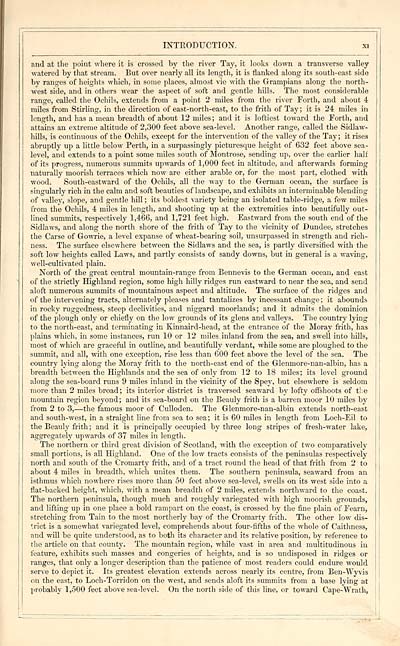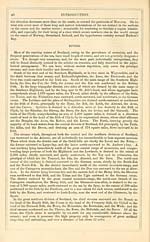Download files
Complete book:
Individual page:
Thumbnail gallery: Grid view | List view

INTRODUCTION. xi
and at the point where it is crossed by the river Tay, it looks down a transverse valley
watered by that stream. But over nearly all its length, it is flanked along its south-cast side
by ranges of heights which, in some places, almost vie with the Grampians along the north-
west side, and in others wear the aspect of soft and gentle hills. The most considerable
range, called the Ochils, extends from a point 2 miles from the river Forth, and about 4
miles from Stirling, in the direction of east-north-east, to the frith of Tay ; it is 24 miles in
length, and has a mean breadth of about 12 miles; and it is loftiest toward the Forth, and
attains an extreme altitude of 2,300 feet above sea-level. Another range, called the Sidlaw-
hills, is continuous of the Ochils, except for the intervention of the valley of the Tay ; it rises
abruptly up a little below Perth, in a surpassingly picturesque height of 632 feet above sea-
level, and extends to a point some miles south of Montrose, sending up, over the earlier half
of its progress, numerous summits upwards of 1,000 feet in altitude, and afterwards forming
naturally moorish terraces which now are either arable or, for the most part, clothed witli
wood. South-eastward of the Ochils, all the way to the German ocean, the surface is
singularly rich in the calm and soft beauties of landscape, and exhibits an interminable blending
of valley, slope, and gentle hill ; its boldest variety being an isolated table-ridge, a few miles
from the Ochils, 4 miles in length, and shooting up at the extremities into beautifully out-
lined summits, respectively 1,466, and 1,721 feet high. Eastward from the south end of the
Sidlaws, and along the north shore of the frith of Tay to the vicinity of Dundee, stretches
the Carse of Gowrie, a level expanse of wheat-bearing soil, unsurpassed in strength and rich-
ness. The surface elsewhere between the Sidlaws and the sea, is partly diversified with the
soft low heights called Laws, and partly consists of sandy downs, but in general is a waving,
well-cultivated plain.
North of the great central mountain-range from Bennevis to the German ocean, and east
of the strictly Highland region, some high hilly ridges run eastward to near the sea, and send
aloft numerous summits of mountainous aspect and altitude. The surface of the ridges and
of the intervening tracts, alternately pleases and tantalizes by incessant change ; it abounds
in rocky ruggedness, steep declivities, and niggard moorlands; and it admits the dominion
of the plough only or chiefly on the low grounds of its glens and valleys. The country lying
to the north-east, and terminating in Kinnaird-head, at the entrance of the Moray frith, has
plains which, in some instances, run 10 or 12 miles inland from the sea, and swell into hills,
most of which are graceful in outline, and beautifully verdant, while some are ploughed to the
summit, and all, with one exception, rise less than 600 feet above the level of the sea. The
country lying along the Moray frith to the north-east end of the Glenmore-nan-albin, has a
breadth between the Highlands and the sea of only from 12 to 18 miles; its level ground
along the sea-board runs 9 miles inland in the vicinity of the Spey, but elsewhere is seldom
more than 2 miles broad; its interior district is traversed seaward by lofty offshoots of the
mountain region beyond; and its sea-board on the Beauly frith is a barren moor 10 miles by
from 2 to 3, — the famous moor of Culloden. The Glenmore-nan-albin extends north-east
and south-west, in a straight line from sea to sea; it is 60 miles in length from Loch-Eil to
the Beauly frith ; and it is principally occupied by three long stripes of fresh-water lake,
aggregately upwards of 37 miles in length.
The northern or third great division of Scotland, with the exception of two comparatively
small portions, is all Highland. One of the low tracts consists of the peninsulas respectively
north and south of the Cromarty frith, and of a tract round the head of that frith from 2 to
about 4 miles in breadth, which unites them. The southern peninsula, seaward from an
isthmus which nowhere rises more than 50 feet above sea-level, swells on its west side into a
flat-backed height, which, with a mean breadth of 2 miles, extends northward to the coast.
The northern peninsula, though much and roughly variegated with high moorish grounds,
and lifting up in one place a bold rampart on the coast, is crossed by the fine plain of Fearn,
stretching from Tain to the most northerly bay of the Cromarty frith. The other low dis-
trict is a somewhat variegated level, comprehends about four-fifths of the whole of Caithness,
and will be quite understood, as to both its character and its relative position, by reference to
the article on that county. The mountain region, while vast in area and multitudinous in
feature, exhibits such masses and congeries of heights, and is so undisposed in ridges or
ranges, that only a longer description than the patience of most readers could endure would
serve to depict it. Its greatest elevation extends across nearly its centre, from Ben-Wyvis
on the east, to Loch-Torridon on the west, and sends aloft its summits from a base lying at
probably 1,500 feet above sea-level. On the north side of this line, or toward Cape- Wrath,
and at the point where it is crossed by the river Tay, it looks down a transverse valley
watered by that stream. But over nearly all its length, it is flanked along its south-cast side
by ranges of heights which, in some places, almost vie with the Grampians along the north-
west side, and in others wear the aspect of soft and gentle hills. The most considerable
range, called the Ochils, extends from a point 2 miles from the river Forth, and about 4
miles from Stirling, in the direction of east-north-east, to the frith of Tay ; it is 24 miles in
length, and has a mean breadth of about 12 miles; and it is loftiest toward the Forth, and
attains an extreme altitude of 2,300 feet above sea-level. Another range, called the Sidlaw-
hills, is continuous of the Ochils, except for the intervention of the valley of the Tay ; it rises
abruptly up a little below Perth, in a surpassingly picturesque height of 632 feet above sea-
level, and extends to a point some miles south of Montrose, sending up, over the earlier half
of its progress, numerous summits upwards of 1,000 feet in altitude, and afterwards forming
naturally moorish terraces which now are either arable or, for the most part, clothed witli
wood. South-eastward of the Ochils, all the way to the German ocean, the surface is
singularly rich in the calm and soft beauties of landscape, and exhibits an interminable blending
of valley, slope, and gentle hill ; its boldest variety being an isolated table-ridge, a few miles
from the Ochils, 4 miles in length, and shooting up at the extremities into beautifully out-
lined summits, respectively 1,466, and 1,721 feet high. Eastward from the south end of the
Sidlaws, and along the north shore of the frith of Tay to the vicinity of Dundee, stretches
the Carse of Gowrie, a level expanse of wheat-bearing soil, unsurpassed in strength and rich-
ness. The surface elsewhere between the Sidlaws and the sea, is partly diversified with the
soft low heights called Laws, and partly consists of sandy downs, but in general is a waving,
well-cultivated plain.
North of the great central mountain-range from Bennevis to the German ocean, and east
of the strictly Highland region, some high hilly ridges run eastward to near the sea, and send
aloft numerous summits of mountainous aspect and altitude. The surface of the ridges and
of the intervening tracts, alternately pleases and tantalizes by incessant change ; it abounds
in rocky ruggedness, steep declivities, and niggard moorlands; and it admits the dominion
of the plough only or chiefly on the low grounds of its glens and valleys. The country lying
to the north-east, and terminating in Kinnaird-head, at the entrance of the Moray frith, has
plains which, in some instances, run 10 or 12 miles inland from the sea, and swell into hills,
most of which are graceful in outline, and beautifully verdant, while some are ploughed to the
summit, and all, with one exception, rise less than 600 feet above the level of the sea. The
country lying along the Moray frith to the north-east end of the Glenmore-nan-albin, has a
breadth between the Highlands and the sea of only from 12 to 18 miles; its level ground
along the sea-board runs 9 miles inland in the vicinity of the Spey, but elsewhere is seldom
more than 2 miles broad; its interior district is traversed seaward by lofty offshoots of the
mountain region beyond; and its sea-board on the Beauly frith is a barren moor 10 miles by
from 2 to 3, — the famous moor of Culloden. The Glenmore-nan-albin extends north-east
and south-west, in a straight line from sea to sea; it is 60 miles in length from Loch-Eil to
the Beauly frith ; and it is principally occupied by three long stripes of fresh-water lake,
aggregately upwards of 37 miles in length.
The northern or third great division of Scotland, with the exception of two comparatively
small portions, is all Highland. One of the low tracts consists of the peninsulas respectively
north and south of the Cromarty frith, and of a tract round the head of that frith from 2 to
about 4 miles in breadth, which unites them. The southern peninsula, seaward from an
isthmus which nowhere rises more than 50 feet above sea-level, swells on its west side into a
flat-backed height, which, with a mean breadth of 2 miles, extends northward to the coast.
The northern peninsula, though much and roughly variegated with high moorish grounds,
and lifting up in one place a bold rampart on the coast, is crossed by the fine plain of Fearn,
stretching from Tain to the most northerly bay of the Cromarty frith. The other low dis-
trict is a somewhat variegated level, comprehends about four-fifths of the whole of Caithness,
and will be quite understood, as to both its character and its relative position, by reference to
the article on that county. The mountain region, while vast in area and multitudinous in
feature, exhibits such masses and congeries of heights, and is so undisposed in ridges or
ranges, that only a longer description than the patience of most readers could endure would
serve to depict it. Its greatest elevation extends across nearly its centre, from Ben-Wyvis
on the east, to Loch-Torridon on the west, and sends aloft its summits from a base lying at
probably 1,500 feet above sea-level. On the north side of this line, or toward Cape- Wrath,
Set display mode to: Large image | Transcription
Images and transcriptions on this page, including medium image downloads, may be used under the Creative Commons Attribution 4.0 International Licence unless otherwise stated. ![]()
| Gazetteers of Scotland, 1803-1901 > Imperial gazeteer of Scotland, or, Dictionary of Scottish topography > Volume 1 > (25) Page xi |
|---|
| Permanent URL | https://digital.nls.uk/97459430 |
|---|
| Description | Volume I: Aan-Gordon. |
|---|---|
| Attribution and copyright: |
|

